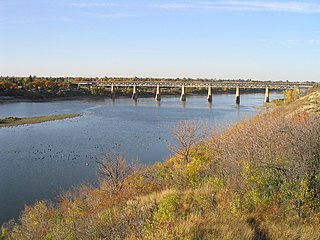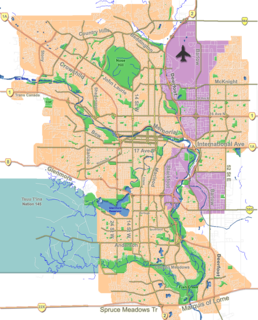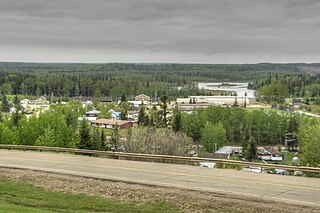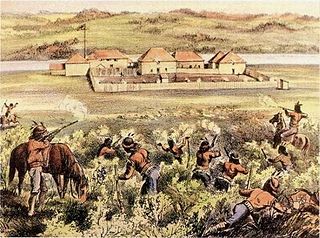Related Research Articles

The Hudson's Bay Company is a Canadian retail business group. A fur trading business for much of its existence, HBC now owns and operates retail stores in Canada and the United States. The company had sold most of its European operations by August 2019 and its remaining stores, in the Netherlands, were to be closed by the end of the year. HBC owns the Saks stores in the US; most other US operations had been sold by mid-2019 and the last remaining stores were to be sold prior to the end of 2019.

Rupert's Land, or Prince Rupert's Land, was a territory in British North America comprising the Hudson Bay drainage basin, a territory in which a commercial monopoly was operated by the Hudson's Bay Company for 200 years from 1670 to 1870. The area once known as Rupert's Land is now mainly a part of Canada, but a small portion is now in the United States. It was named after Prince Rupert of the Rhine, a nephew of Charles I and the first Governor of the Hudson's Bay Company (HBC). In December 1821, the HBC monopoly was extended from Rupert's Land to the Pacific coast.

The North West Company was a fur trading business headquartered in Montreal from 1779 to 1821. It competed with increasing success against the Hudson's Bay Company in what is present-day Western Canada. With great wealth at stake, tensions between the companies increased to the point where several minor armed skirmishes broke out, and the two companies were forced by the British government to merge.

The Saskatchewan River is a major river in Canada, about 550 kilometres (340 mi) long, flowing roughly eastward across Saskatchewan and Manitoba to empty into Lake Winnipeg. Through its tributaries the North Saskatchewan and South Saskatchewan, its watershed encompasses much of the prairie regions of central Canada, stretching westward to the Rocky Mountains in Alberta and northwestern Montana in the United States. It reaches 1,939 kilometres (1,205 mi) to its farthest headwaters on the Bow River, a tributary of the South Saskatchewan in Alberta.
Pacific Western Airlines Ltd (PWA) was an airline that operated scheduled flights throughout western Canada and charter services around the world from the 1950s through the 1980s.
Fort Edmonton was the name of a series of trading posts of the Hudson's Bay Company from 1795 to 1891, all of which were located in central Alberta, Canada. From 1795 to 1821 it was paired with the North West Company's Fort Augustus. It was the end point of the Carlton Trail, the main overland route for Metis freighters between the Red River Colony and the west and an important stop on the York Factory Express route between London, via Hudson Bay, and Fort Vancouver in the Columbia District.

Fort Calgary was established in 1875 as Fort Brisebois by the North-West Mounted Police at the confluence of the Bow and Elbow rivers, on traditional Niitsitapi (Blackfoot) territory in what is now called Calgary. The fort was built to control the illegal American whiskey trade, to make way for the coming Canadian Pacific Railway, and to create 'good relations' with the Indigenous peoples of the territory. The site was purchased by the City of Calgary in 1974 and reopened in 1978 as a historic site and museum.
BP Canada Energy Group ULC, is a Canadian oil and gas company headquartered in Calgary, Alberta, and a subsidiary of BP plc.
John Rowand was a fur trader for the North West Company and later, the Hudson's Bay Company. At the peak of his career, he was Chief Factor at Fort Edmonton, and in charge of the HBC's vast Saskatchewan District.

Heritage Park Historical Village is a historical park in Calgary, Alberta, Canada, on 127 acres (51 ha) of parkland on the banks of the Glenmore Reservoir, along the city's southwestern edge. As Canada's second largest living history museum, it is one of the city's most visited tourist attractions. Exhibits span western Canadian history from the 1860s to the 1950s. Many of the buildings are historical and were transported to the park to be placed on display. Others are re-creations of actual buildings. Most of the structures are furnished and decorated with genuine artifacts. Staff dress in historic costume, and antique automobiles and horse-drawn vehicles service the site. Calgary Transit provides regular shuttle service from Heritage C-Train station. The park opened on July 1, 1964.

What is today the province of Alberta, Canada, has a history and prehistory stretching back thousands of years. Recorded or written history begins with the arrival of Europeans. The rich soil was ideal for growing wheat, and the coming of the railroads in the late 19th century led a to large-scale migration of farmers from Eastern Canada, the United States, and Europe. Wheat remains important, but the farms are much larger and the rural population much smaller. Alberta has urbanized and its economic base has expanded from the export of wheat but the export of oil as well.
Silas Alexander Ramsay was a Canadian politician and merchant in Alberta, Canada. He served as the 14th mayor of Calgary.

Fort Assiniboine is a hamlet in northwest Alberta, Canada, within Woodlands County. It is located along the north shore of the Athabasca River at the junction of Highway 33 and Highway 661. It is approximately 39 kilometres (24 mi) northwest of Barrhead, 62 kilometres (39 mi) southeast of Swan Hills and 91 kilometres (57 mi) northeast of Whitecourt.

RMS Nascopie was a steamship built by Swan Hunter and Wigham Richardson of Newcastle upon Tyne, England. She was launched on December 7, 1911 and achieved speeds of 14.1 knots (26 km/h) during her sea trials. She was powered by triple expansion steam engines with cylinders 21.5, 35.5 and 58 inches in diameter and a stroke of 42 inches (1067 mm). Her boiler pressure was 180 pounds-force per square inch and the two main boilers were 15 feet in diameter and 11.5 feet long, fired by six furnaces.

Fort Pitt was a fort built in 1830 by the Hudson's Bay Company that also served as a trading post on the North Saskatchewan River in Canada. It was built at the direction of Chief Factor John Rowand, previously of Fort Edmonton, in order to trade for bison hides, meat and pemmican. Pemmican, dried buffalo meat, was required as provisions for HBC's northern trading posts.
The history of the Northwest Territories begins with the population of the region by First Nations peoples, and proceeds through the transformation of it into provinces and territories of the nation of Canada, including the modern administrative unit of the Northwest Territories. When Europeans settlers began to divide the continent, the Northwest Territories included much of the sparsely populated regions of what is now western Canada. Over time, the provinces of Alberta, Saskatchewan, and Manitoba were formed out of the territories. In 1898, the Yukon territory became a separate entity and in 1999 Nunavut was formed from the eastern section.

Robert Terrill Rundle was a Cornish Wesleyan Methodist missionary from Cornwall, UK. His most noteworthy activities relate to his missionary work in Western Canada between 1840 and 1848.

Peter Fidler was a British surveyor, map-maker, fur trader and explorer who had a long career in the employ of the Hudson's Bay Company (HBC) in what later became Canada. He was born in Bolsover, Derbyshire, England and died at Fort Dauphin in present-day Manitoba. He married Mary Mackagonne, a Cree woman, and together they had 14 children.
This is a timeline of the history of Calgary.

Revillon Frères was a French fur and luxury goods company, founded in Paris in 1723. Then called la Maison Givelet, it was purchased by Louis-Victor Revillon in 1839 and soon, as Revillon Frères, became the largest fur company in France. Branches were opened in London in 1869 and in New York in 1878. At the end of the 19th century, Revillon had stores in Paris, London, New York City, and Montreal.
References
- 1 2 Klassen, Henry Cornelius. Eye on the future: business people in Calgary and the Bow Valley, 1870-1900. Calgary: Univ. Alberta Press, 2002." Ch 2 is about the Conrads & I. G. Baker & Co., but ch. 1 & 3 are also pertinent.
- ↑ "HBC Heritage - Our History - Places: Calgary". Hudson's Bay Company . Retrieved 2009-05-17.
In 1891 the Company bought out the Canadian assets of I.G. Baker
- ↑ Foran, Max (1982). Calgary, Canada's frontier metropolis : an illustrated history. Windsor Publications. p. 40. ISBN 0-89781-055-4.